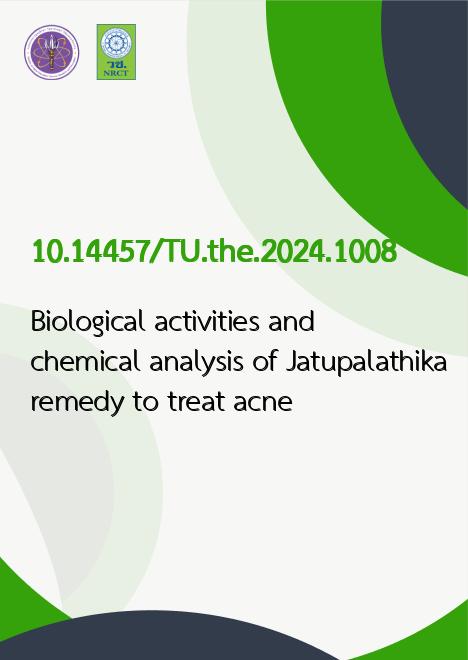
|
Biological activities and chemical analysis of Jatupalathika remedy to treat acne |
|---|---|
| รหัสดีโอไอ | |
| Title | Biological activities and chemical analysis of Jatupalathika remedy to treat acne |
| Creator | Jittiporn Chaorai |
| Contributor | Sumalee Panthong, Advisor |
| Publisher | Thammasat University |
| Publication Year | 2567 |
| Keyword | Jatupalathika remedy, Anti-bacterial, Acne, Herbal medicine |
| Abstract | The beginning of acne has been caused by an increase in sebum production, whereas follicular hyperkeratosis leads to the formation of microcomedones. Comedones are formed when keratinocytes clog the pilosebaceous ducts, and an accumulation of sebum allows for the proliferation of Cutibacterium acnes. In addition, Staphylococcus aureus and Staphylococcus epidermidis have the ability to infect and trigger inflammation in acne. The inflammation causes an abnormal process of keratinization in the sebaceous follicle, resulting in increased activity of the enzyme tyrosinase. As a result, there is an excessive synthesis of melanin in the skin. Following the treatment of acne to minimize its severity, post inflammatory hyperpigmentation or dark patches are observed in the area where the acne lesions were present. Currently, herbal therapy is utilized for the treatment of acne and various illnesses. Specifically, herbs that contain tannin have the ability to prevent the growth of bacteria. The Jatupalathika remedy is a herbal composition that contains four plant constituents, namely Terminalia chebula Retz., Terminalia arjuna (Roxb. ex DC.) Wight & Arn., Terminalia bellirica (Gaertn.) Roxb., and Phyllanthus emblica L., all in equal proportions. Nevertheless, there have been no reports regarding the antibacterial activity of Jatupalathika. The aim of this study was to examine the antibacterial properties that cause acne, anti-inflammatory activity, anti-tyrosinase effects, and wound-healing potential of Jatupalathika and its plant constituent extracts. Furthermore, a study was conducted to determine the amount of chemical components present in Jatupalathika and its plant ingredient extracts. The Jatupalathika extract was performed stability testing under accelerated conditions. The findings indicated that maceration with 95% ethanol is the most effective technique for extracting the most potent extract. The maceration extract shown antibacterial efficacy against C. acnes, S. aureus, and S. epidermidis. The reflux extract and aqueous extract both exhibited antibacterial activity, but to less effect. The minimum inhibitory concentration (MIC) range for all extracts was 156.25 to 1,250 µg/mL. The Jatupalathika plant extracts effectively inhibited the proliferation of C. acnes, S. aureus, and S. epidermidis. The maceration extract of T. arjuna had the highest level of antibacterial activity against C. acnes. In contrast, the reflux extract of T. arjuna exhibited the most potent antibacterial action against S. aureus and S. epidermis. In addition, none of the Jatupalathika extracts shown any anti-inflammatory effects, anti-tyrosinase activity, or wound healing characteristics. The presence of gallic acid and chebulagic acid was detected in the Jatupalatika extracts. The maceration extract of Jatupalathika demonstrated the highest levels of gallic acid and chebulagic acid, measuring 4.78% and 7.99% respectively. This was followed by the reflux extract and aqueous extract. Gallic acid and chebulagic acid demonstrated antibacterial activity against S. aureus and S. epidermidis, while gallic acid inhibited the growth of C. acnes. The stability of the maceration extract of Jatupalathika was assessed under accelerated conditions. Upon analysis, it was shown that the maceration extract of Jatupalathika displayed its antibacterial activity and chemical composition. The Jatupalathika treatment can inhibit the proliferation of bacteria. Therefore, this therapy demonstrates potency in treating the bacteria causing acne and holds potential for development as an anti-acne medication. Before starting product development, it is necessary to perform a safety assessment on human skin to investigate the potential adverse effects of Jatupalathika extract. Performing a study on the antibacterial activity of Jatupalathika extract against antibiotic-resistant bacteria is essential to determine its potential for wide use in the future. |